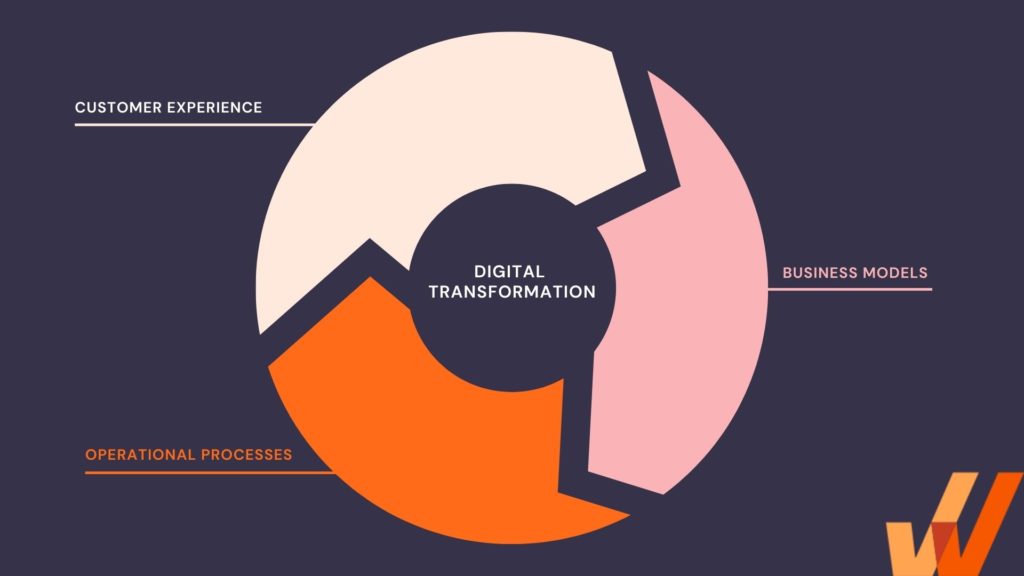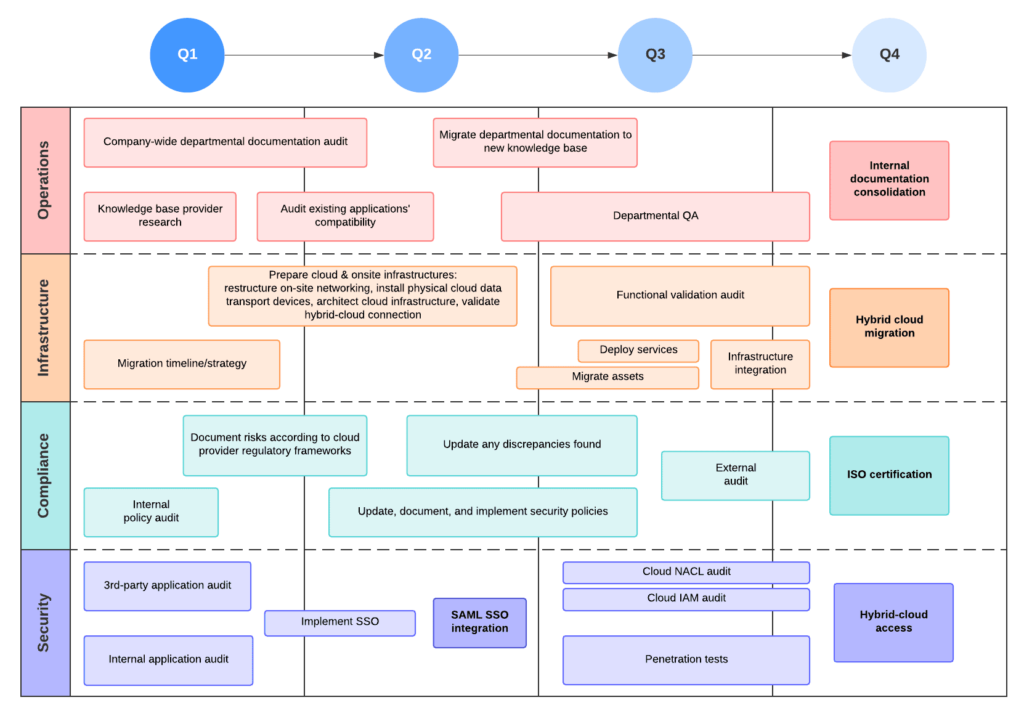What Is Digital Transformation?
Digital transformation is the process of using digital technologies to transform existing traditional and non-digital business processes and services, or creating new ones, to meet with the evolving market and customer expectations, thus completely altering the way businesses are managed and operated, and how value is delivered to customers.
According to Deloitte, “digital transformation is all about becoming a digital enterprise—an organization that uses technology to continuously evolve all aspects of its business models (what it offers, how it interacts with customers and how it operates).”
As technology evolves, so should your business. At this point, it’s not about enterprises choosing to transform; it’s more about deciding how to transform.
Digital transformation is about evolving your business by experimenting with new tech and rethinking your current approach to common issues. Because it’s an evolution, a transformation doesn’t necessarily have a clear end point. The MIT Sloan Management Review, a publication that focuses on how management transforms in the digital age, says, “Digital transformation is better thought of as continual adaptation to a constantly changing environment.”
For enterprises, that means continually seeking out ways to improve the end-user experience. This could be through offering improved on-demand training, migrating data to cloud services, leveraging artificial intelligence, and more.
3 Key Areas of Enterprise Digital Transformation
MIT Sloan Management Review highlights three key areas of digital transformation for enterprises:
- Customer Experience — working to understand customers in more detail, using technology to fuel customer growth, and creating more customer touchpoints
- Operational Processes — improving internal processes by leveraging digitization and automation, enabling employees with digital tools, and collecting data to monitor performance and make more strategic business decisions
- Business Models — transforming the business by augmenting physical offerings with digital tools and services, introducing digital products, and using technology to provide global shared services

- Digital Transformation in Banking
- Digital Transformation in Government
- Digital Transformation in Healthcare
- Digital Transformation in Higher Education
- Digital Transformation in HR
- Digital Transformation in Nonprofits
- Digital Transformation in PC Insurance
- Digital Transformation in Manufacturing
- Digital Transformation in Pharma
- Digital Transformation in Retail
- Digital Transformation in Staffing
What Is the Importance of Digital Transformation?
While every digital transformation initiative will have its own specific goals, the primary purpose of any digital transformation is to improve your current processes. Digital transformation is necessary because companies must evolve to remain competitive. If you aren’t evolving, you’re falling behind.
Let’s look at a recent example highlighting the critical nature of digital transformation – Southwest Airlines.
This past holiday season, a major winter storm slammed the US on December 21st, causing major cancellations across airline companies. However, as every other airline company was able to get people to their destinations the next day, Southwest canceled 15,000+ flights on December 22nd, and continued to cancel over 2,500 flights a day over the next week.

The culprit behind this chaos?
A decade-old scheduling system that had already caused smaller issues and that the Southwest Airlines Pilot Association union had been warning the company about since the 1990s.
Southwest failed to keep its IT software and infrastructure modernized, and it cost the company millions in revenue, an enormous about of negative PR, and ravished the company’s image with its customers.
But while digital transformation is a must to avoid IT meltdowns, it’s not as simple as upgrading legacy systems.
A Bain & Company study shows that “only 8% of global companies have been able to achieve their targeted business outcomes from their investments in digital technology.” One of the strategies that set leaders apart is that they spend more on transforming their businesses instead of just running them.
Digital transformation is important because it allows organizations to adapt to ever-changing industries and continually improve how they operate.
For enterprises, that means continually seeking out ways to improve the end-user experience. This could be through offering improved on-demand training, migrating data to cloud services, leveraging artificial intelligence, and more.
The Benefits of Digital Transformation
While the ROI of digital transformation depends on a variety of factors, the right technology can greatly improve how your business functions and how customers engage with it.
- Increases productivity while reducing labor costs — Using technology to work more efficiently is one of the most impactful ways to transform your business. For example, for enterprises, the time and money they spend training new employees and updating digital resources can quickly get out of hand. With the proper tools, you can keep costs down and productivity up.
- Improves the customer experience — Tech-savvy customers want a great experience through multiple touchpoints — mobile apps, social media, email, live chat, etc. Digital transformations are the driving force behind improved customer experiences.
- Drives innovation, keeping you ahead of your competition – Your competitors are looking into digital transformation regardless of whether or not you are. Choosing not to embrace digital transformation is essentially deciding that you don’t mind being left behind. Investing in your organization’s future allows for
- Enables flexibility and scalability: Cloud transformation offers scalability that traditional IT infrastructure cannot. As a business grows or experiences fluctuating demand, it can quickly scale its cloud resources up or down. This flexibility minimizes the risk of system overload, unnecessary expenses on unused resources, or downtime from overloading servers.
Examples of Digital Transformation
Digital transformation is occurring across all industries and job functions. We’ve broken up real-world digital transformation examples by both for you to get a better understanding of the implications of digital transformation.
Examples of Digital Transformation by Job Function
To better understand the impact of digital transformation, let’s explore key ways digitalization is reimagining core business functions like customer service, HR, and sales.
Customer Service
Contact center transformation modernizes an organization’s inbound customer service and support processes and systems through new digital communication channels, AI, and cloud-based help desks for managing customer issues, routing tickets, and centralizing all support-related tasks.
Help desk providers like Zendesk centralize all communications channels (social media, live chat, email, phone calls) into one system, allowing call centers to automate routine tasks and inbound issues. Built-in knowledge bases provide self-service solutions to customers to resolve their problems independently. Service agents can manage dozens of tickets throughout their day and track progress over the days to come. Built-in analytics empower service teams to understand where issues are happening and how to streamline ticket resolution.
HR
HR transformation enables HR teams to improve the employee experience by offering self-service HR services, aggregating people-related data to make more informed decisions, and automating core HR operations and tasks.
A key component of modern HR transformation projects is the implementation of cloud HCM systems like Workday, SAP SuccessFactors, or ADP Workforce Now. HCM transformation overhauls HR’s approach to workforce management by reimagining HR processes through automation and self-service tools. For example, benefits enrollment, paid time off requests, time tracking, and performance reviews were all previously manual, tedious tasks. Now, they’re embedded in online, self-service platforms that provide employees with a streamlined experience.
Additionally, HR transformation enables people teams to aggregate HR analytics from various sources—hiring, pulse surveys, training feedback, performance reviews, skill analysis, and more—into one data moat that powers data-driven HR decision-making.
Sales
CRM transformation involves migrating from managing customers and sales prospects in spreadsheets to a cloud CRM like Salesforce. Sales teams can further transform their processes with Salesforce Sales Cloud, which includes additional sales technologies like Salesforce CPQ and integrates engagement and intent data to provide sellers with intent signals.
Examples of Digital Transformation by Industry
Digital transformation also disrupts verticals – let’s explore different business sectors to see examples of how digitalization is changing industries:
| Industry | Transformation Example(s) | Real-World Example |
| Healthcare | EHR systems, telemedicine, and patient portals | Brigham Health uses virtual visits allowing patients to schedule appointments online and conduct a screening via web video. |
| Hospitality | Online check-in, amenity booking tools, property management system (PMS), and centralized reservation system. | Harrah’s uses online check-in so guests can skip the in-person process. |
| Insurance | Virtual quotes, online claims process, self-service policyholder experiences, automated underwriting. | Lemonade uses an online portal for prospective customers to get instant quotes, as well as a portal for customers to file claims online – both using AI-powered technology. |
| Property Management | Property management systems for self-service renter applications, signing documents, automatic rent payment, and service requests – while also improving internal operations like accounting, auditing, vacancy optimization, and property listings. | Draper Reality implements Buildium across its 128 properties to create a single repository for its applications and leases, reducing its time-to-processing applications from 5 days to 2 hours. It also provided a better tenant experience, integrating e-payments, service requests, and community features into one single self-service platform. |
| Retail | Loyalty cards, e-commerce stores, mobile apps, variable pricing structures. | Target encourages its uses to download the Target App where it can reach customers through in-app and push notifications instantly, as well as creates a new stream of revenue with its online store |
Most Important Aspects of Digital Transformation
To successfully transform, keep the momentum of any initiative moving toward your ultimate business goals. To do so, continually address the main drivers of digital transformation: digital twin, privacy, culture, augmented intelligence, and digital product management.
According to Gartner, CIOs need to focus on these areas to enable successful digital transformations in their organizations.
1. Cloud Adoption
Cloud transformation is the total process of moving from on-prem data storage and desktop applications to cloud applications and services to improve business processes and operations, drive revenue, meet evolving customer experiences, and build organizational resilience.
According to McKinsey, adopting cloud technologies has contributed to more than $1 trillion in value for Fortune 500 companies alone, and Gartner predicts that total worldwide spending on cloud technologies and services will surpass $597 billion in 2024 alone – up 21.5% YoY.
According to a 2024 TechTarget Enterprise Strategy Report, 47% of organizations are already deploying a cloud-first technology strategy, with another 27% taking a hybrid approach. The other 26% are still deploying on-premise applications and IT services, but these technology adoption laggards overwhelmingly state they’re considering a migration to a cloud-centric approach in the near future.
The five largest cloud marketers based on IT spend are cloud management and security solutions, business process as a service (BPaaS), cloud infrastructure as a service (IaaS), Cloud Platform as a Service (PaaS), and cloud application services (general SaaS products).
2. Digital Twins
Gartner defines digital twin as “a digital representation of a real-world entity or system. The implementation of a digital twin is an encapsulated software object or model that mirrors a unique physical object, process, organization, person or other abstraction.”
Digital twins support digital transformation because they facilitate experimentation and collect data that supports more informed business decisions.
3. Privacy
If you can’t manage privacy, your digital transformation is destined to fail. As more digital solutions become available, organizations tend to jump on trends that offer more convenience. However, Gartner’s research reveals that a large portion of consumers and employees are not willing to give up safety and security just for convenience.CIOs need to take privacy seriously. Employees and consumers won’t support a transformation if they feel it violates their privacy or personal data security.
4. Culture
Resistance to change is a human instinct. When you ignore the cultural aspect of a digital transformation, you’ll start hitting walls of resistance fairly quickly. In fact, 46% of CIOs say culture is their biggest barrier to change. Addressing culture ensures you get internal buy-in for your transformation initiative. When you have change leaders — vocal supporters of your digital transformation — you can use their voices to drive your initiative forward.
5. Augmented Intelligence
Augmented intelligence goes beyond artificial intelligence (AI), allowing humans and machines to work in tandem.AI’s data collection and analysis capabilities far surpass that of a human worker. But augmented intelligence isn’t about replacing employees with machines — AI collects and presents data in a way that allows people to augment their knowledge.
6. Digital Product Management
Gartner explains digital product management as the shifting of mindsets from projects to products. Those products must be designed to improve the customer experience and be delivered through digital channels. Digital product management is about knowing your industry and designing products that serve it. For example, instead of expecting the healthcare industry to align with Apple’s offerings, Apple created a watch that monitors the health of the wearer.CIOs who focus on these five key drivers can stay ahead of their competition by constantly improving and growing their businesses.
Why Digital Transformation Projects Fail
Digital transformations fail for many reasons, but most issues can be linked back to one of three digital transformation challenges: people, communication, and measurement. Let’s dive further into each:
1. People
People can make or break your digital transformation. Remember: culture is both a top driver of digital transformation and one of the six pillars of successful ones. If you don’t put enough focus on people and culture, your initiative is bound to fail. Sixteen of McKinsey’s 21 keys to success in digital transformation involve people.
2. Poor communication
Announcing a digital transformation initiative is not the same as communicating with your team about it. Often, leadership simply mandates changes without taking the time to explain the why and how. If you don’t provide specific and actionable guidance before, during, and even after a transformation, your initiative won’t make it very far. You can learn more by reading our guide to change communciation.
3. Lack of measurement
You can’t have a successful digital transformation if you failed to define what success means to you. Companies sometimes assume they can monitor success based on the key performance metrics (KPIs) they’ve already established for their business. But if you’re changing the way you do business, you’ll need to set additional KPIs to monitor the effects.
Risks of Slow Digital Transformation
Organizations that become “future-ready” through successful digital transformation see a 14% higher net margin than similar companies in their industry yet to achieve transformation through digitalization.
On top of the negative impact on revenue growth, slow digital transformation initiatives also:
- Restrict companies from growth and innovation, making them lose ground to their competitors.
- Negatively impacts customer experience as applications, services, and processes become outdated.
- Reinforces legacy habits for employees that contribute to future resistance to change that requires additional reskilling.
- Fails to empower employees with the tools they need to maximize their performance, productivity, and output.
- Strengths data silos throughout the organization, leading to speculation when making decisions and departments not sharing data and information.
How to Accelerate Digital Transformation
A digital transformation strategy is a plan of action for introducing, analyzing, and driving a digital transformation initiative forward. Your strategy will define what business goals you aim to achieve and help accelerate digital transformation.
An effective digital transformation strategy will create a framework for you to follow throughout this ever-evolving process. But before you begin, it’s important to know what you hope to achieve so you can designate KPIs to track along the way.
Here are ten digital transformation acceleration strategies that empower organizations to build, integrate, and launch new digital initiatives that help drive end-user adoption and allow organizations to find value in their technology investments
1. Build an IT roadmap that aligns with your business’s contextual drivers, goals, and needs
While new business technologies may sound exciting, organizations must invest in transformation projects that drive business outcomes aligned with their key drivers and business needs.
First, this means communicating with and educating all leaders – specifically, IT leaders and department heads who are technology decision-makers – on your business’s core needs. This leads to faster development cycles and fewer failed software implementations.
Organizations should also map their future technology investments and business needs the same way product managers roadmap product and feature development, with an IT roadmap. An IT roadmap outlines the overall goals, technologies, tactics, and more in an IT strategic plan that shows how these investments will align with overall business objectives.

2. Provide upskilling training to improve your workforce’s digital literacy
54% of organizations say they cannot achieve digital transformation goals because of a lack of digital literacy across their workforce.
This was brought into focus even more in our recent 2024 Digital Adoption Trends Report, where 78% of employees say they lack expertise in the tools they use daily and could use additional training and support. Another 84% of employees said there are core features and processes in the software they use daily that they don’t know how to use.
While a significant challenge, this can be overcome by continuously upskilling employees to build digital dexterity through various types of employee training – even before you begin your digital transformation efforts.
Many organizations view digital transformation efforts as a way to drive more employee output. Still, it should be viewed as the reverse – digital transformation enables employees to be more productive and perform better by automating routine tasks, leveraging technology to assist them, and being more innovative.
Remember, not all your employees need the same level of upskill training. Your IT and L&D team should work together to identify what cohorts of employees need additional training through a skills gap analysis assessment. This may differ based on employee traits and backgrounds, like age, role, job experience, etc.
3. Invest in customer experiences that meet their needs
Digital transformation efforts typically fall in two categories: operational improvements internally and improving customer experiences. For launching customer-facing transformation projects, there is no better substitute than listening to what your customers have to say about your product or service.
Read customer reviews, gather customer feedback, and set up 1-1 customer meetings with your most valuable partners to understand their expectations of your service. Your customer-facing transformation investments should solve the challenges and problems identified from your customer research.
You should also make it simpler for customers to use your software, which includes providing better customer onboarding experiences and enabling them with self-service support.
A few of the most common customer experience transformation projects to invest in include:
- Creating multichannel experiences for customers.
- Building more contextual experiences for customers.
- Providing a more seamless service and support experience with self-help resources.
4. Monitor the adoption of new employee-based applications and customer-facing experiences
A critical stage of the transformation process is the adoption phase. This is when employees and customers realize the value of new technology or change, and habits form and are built into their workflows. To measure digital adoption, you must track user behavior with event-based product analytics.
With an adoption analytic framework, you can:
- Build cohorts of end-users that adopt new technologies differently, allowing you to build contextual onboarding and guidance for their persona.
- Spot friction and dropoff areas inside your digital processes and tools.
- Identify common support and trouble issues you can remedy with new end-user documentation, how-to articles, and in-app guidance.
5. Adopt an agile approach to all business operations and processes
With digital transformation adapting to new technologies constantly (ie. see the rapid advancement and integration of AI into everything), IT leaders must embrace the agile methodology as a core company principle. This means building in agile technology frameworks and infrastructure, as 87% of digital leaders say that the ability of their organization to be competitive is highly dependent on their technology architecture’s flexibility.
An agile change strategy also means fostering an agile mindset regarding company culture. Having innovative team members that can quickly adapt to change means your employees will be less likely to resist change, be able to adopt new tools and processes rapidly, have a more open-minded approach to problem-solving, and empower your organization to be more nimble.
6. Invest in tools and build processes that are reusable and can be repurposed
Organizations must focus on investing in the right software and technology investments and in digital ecosystems that can be used for many use cases, help solve many use cases and challenges, share data through APIs, and that integrate natively together. This is critical when modernizing legacy applications to prepare for future needs and scaling.
Organizations must also avoid investing in technology for the sake of investing in technology. According to a recent report from Asana, the average employee uses 13 tools 30 times daily. A report from Vendr found that the average organization wasted $135,000 in 2020 on unused software or duplicate software subscriptions. One option to avoid investing in the wrong technology is to hire a digital transformation consulting company.
7. Provide your employees with performance self-support tools
IT and L&D leaders too often think of training as a one-and-done event. However, employees often encounter issues with digital tasks, especially when completing irregular tasks (ie. performance reviews, data audits, compliance-related tasks, etc).
From our 2024 Digital Adoption Trends Report, 76% of end users said accessing and finding software training and help content is difficult. This compounds with applications releasing product enhancements and new features and companies tweaking or full-on changing internal processes.
This leads to employees becoming frustrated with their digital applications and tasks, leading to poor adoption, lower productivity due to searching for answers independently, and many internal IT support tickets.
To overcome this, organizations should support their team members with employee performance support tools that provide them with contextual self-service help, in the flow of work.
A digital adoption platform (DAP) like Whatfix provides employees with a Self-Help wiki similar to an IT self-service portal that overlays on digital applications and connects with a companies knowledge base, internal wiki, Google Drive, SharePoint, third-party websites, and any form of documentation – allowing employees to find answers at the moment of need.

Whatfix also empowers IT and L&D leaders to add in-app tooltips, beacons, and pop-ups to alert employees of changes to a workflow, new features, or provide them with a guided flow to help finish an irregular task.

8. Become a data-driven company
One of the drivers of digital transformation is to break down data silos and empower organizations with the analytics they need to make data-driven decisions. Organizations should foster a culture of data literacy through better employee training and more transparent data sharing.
These practices help organizations make better decisions supported by data and uncover previously unseen patterns and trends.
9. Communicate transparently with employees
CIOs and IT leaders may know the challenges they face day-to-day, as well as what the business objectives are. Still, they can’t be aware of every department’s core challenges without speaking directly to department leaders and individual employees.
Fostering an open line of communication between IT leaders and employees will allow those in charge of making IT investments to understand the most critical challenges and digital friction areas facing their workforce and where they need support.
It also allows IT leaders to openly communicate current IT-related projects and provide warnings and updates on upcoming application and process changes that directly impact individual employees’ routines.
10. Encourage employees and leaders to seek new and emerging technology opportunities
Technology changes rapidly. Those who stay educated on what’s happening in their industry, in the IT world, and on general technology advancements have a leg up on those who follow. Organizations should take advantage of that by providing employees with learning opportunities on emerging trends and technologies, such as lunch and learns, conferences, online subscriptions, and more.
Encourage your employees and leaders to bring new ideas by creating an idea charter system. This will provide a framework for employees to pitch new ideas, help tie them to business objectives, allow organizations to prioritize the interesting ones, and weed out those who aren’t prepared.
Digital Transformation Trends
Different types of transformations rise and fall in popularity as technology changes. Keeping up with trends is a great way to see how you can improve your own digital transformations and prepare for inevitable changes in your industry.
Right now, the hottest trends in digital transformation all tie back to one thing: creating a better customer and employee experience. Although many people, employees in particular, fear that some technology is designed to replace humans, great digital transformations involve technology that complements human work.
AI, Robotic Process Automation, 5G, mobile development, and personalized user experiences are all examples of digital transformation trends that aim to work alongside humans to do everything from improving communication to limiting repetitive work.
How DAPs Accelerate Digital Transformation
A digital adoption platform (DAP), like Whatfix, is a no-code editor that empowers organizations to create in-app overlays, guidance, and self-help support for any end-user – from internal employees to clients, customers, and website visitors.
IT leaders can craft contextual in-app learning experiences, messages, and more, acting as a digital assistant to build digital literacy with end-users, reduce their time-to-value, improve productivity, and empowering outcomes.
Here is a few ways IT, customer success, and L&D teams can accelerate and advance customer-facing and internal digital transformation efforts with a DAP.
1. Create contextual in-app guidance
With Whatfix, IT and L&D leaders can create in-app guidance and learning content right into the end-users applications. The in-app overlays are made with a no-code visual editor and can be branded to appear native.
Whatfix enables non-engineers to create, manage, test, and launch in-app content for use cases such as user onboarding, change management, digital transformation, performance support, end-user support, and more.
A few examples of in-app guidance you can create with Whatfix include:
- Product tours
- Interactive walkthroughs
- Task lists
- Tooltips and beacons
- Alerts and pop-ups
- Self-help wikis
- Field validations

2. Provide on-demand performance support with Self-Help
Whatfix Self-Help connects with your knowledge base, internal process documentation, internal wiki, LMS, third-party links, and other process and how-to articles to bring all that contextual documentation right into your digital applications and workflows. This support end-users in the flow of work, helping them find the answers to their questions or find additional documentation on how to complete a process.
Whatfix’s Self-Help not only overlays on to any application, it also is searchable and uses AI to help identify and find help documentation for users. Organizations can also create guided flows that can be attached to their Self-Help to provide further context on processes and workflows.

3. Analyze end-user engagement and experiences with product analytics
Whatfix Guidance Analytics provides detailed consumption and engagement data on your Whatfix-created in-app guidance and support content. Understand how many users completed their user onboarding Task List, how many users engaged with your Smart Tips, and what the most commonly searched Self Help queries are.
Whatfix Analytics takes this a step further and enables organizations to understand their product usage and engagement with custom event tracking, empowering them to make data-driven decisions.
With a no-code implementation, Whatfix’s product analytics is an event-based analytics framework that allows organizations to map user flows, identify drop-offs and friction points, segment users into cohorts, analyze product trends, and drive product adoption. With Whatfix’s analyze, build, and deliver framework, organizations can then take action based on these analytics.

4. Alert end-users of announcements, product releases, and process changes
With Whatfix’s beacons and pop-ups, you can alert employees or customers to important announcements or guide users to certain areas of your app.
Beacons are pulsating dots that overlay on elements in your application. These beacons have messages that appear when a user hovers over them and can be attached to additional walkthroughs for new features or process changes.
Pop-ups are traditional modal windows that allow organizations to embed a video, making a critical announcement, launch a flow for specific cohorts like for a new user product tour, and more
5. Gather feedback with in-app, real-time surveys
Whatfix also empowers organizations to gather employee and customer feedback with in-app, native surveys that collect end-user and product feedback in real-time. This feedback includes traditional surveys like NPS and general feedback, as well as post-training feedback that helps gauge how effective and helpful specific user onboarding, training, and support flows and experiences are.

Whatfix empowers enterprise digital transformation efforts by userizing software and technology to meet the needs of end-users. Whatfix supports organizations’ digital adoption strategy with contextual in-app guidance and self-help end-user support.
Analyze product adoption with analytics to make data-driven decisions that leading to technology adoption that helps realize maximize ROI from digital transformation efforts and guides companies to digital transformation success.
Digital
Transformation
FAQs
What is the definition of digital transformation?
Digital transformation refers to the use of digital technology to materially evolve or create new business processes.
What are the pillars of digital transformation?
Daniel Newman, principal analyst and founding partner at Futurum Research, says to understand the foundation of digital transformation, you have to look closely at the six pillars of digital transformation.
He argues that digital transformation is not about technology; it’s about “tech-enabled change.” And, to look beyond the technology aspect, focus on the pillars that support the change.
- Experiences — Experiences could refer to the customer and/or employee experience. Successful digital transformations lead to a positive experience for the people who are affected by it. Ask yourself — will this initiative improve how I connect with my customers? Will the transformation help employees become more efficient?
- People — Remember: culture is a top driver of digital transformation as well as its greatest barrier. You cannot neglect the people affected by tech-enabled changes and expect positive results. You can strengthen the people pillar by designating change leaders who actively support and accelerate your transformation. The key is to design an initiative that leverages technology to improve the human experience.
- Change — Transformations can’t happen without change. Luckily, you can address the change pillar by borrowing from proven change management models and best practices in change management communication.The change pillar encourages you to communicate your expectations for a transformation and establish clear goals. This pillar also ties back to the people pillar, as no change can be successful without the support of the people affected by it.
- Innovation — Newman defines innovation as “a sudden spark of creativity that leads to the creation of something that changes the face of your business.”The innovation pillar focuses on creating space for collaboration and new ideas. Innovation supports digital transformation by encouraging businesses to find creative solutions to problems.
- Leadership — If you aren’t leading, no one is following. It’s crucial for leaders to proactively monitor not just the implementation plan but also the outcome of any digital transformation initiative. It’s leadership’s responsibility to establish key performance indicators (KPIs) and guide teams towards a successful transformation.
- Culture — Business culture is a crucial aspect of digital transformation. Newman recommends a people-first approach — worry about employee and customer experience first and then move onto technology.
What is the difference between cloud transformation and digital transformation?
Digital transformation encompasses larger changes or initiatives to modernize your company’s digital landscape, and this may include a cloud transformation. However, cloud transformation can be done without a larger digital transformation initiative.
What are the stages of digital transformation?
After several years of interviews with digital transformation leaders, Altimer released a report that defined six stages of digital transformation. Together, the six stages provide a guide for purposeful, results-driven transformation initiatives.
Here are the six stages of digital transformation
- Business as usual, status quo — The current state of your organization
- Present and active — A time of experimentation throughout the organization when you encourage creativity and improved digital literacy skills
- Formalized — When experimentation becomes more intentional, initiatives become clearer, and you start looking for leadership buy-in
- Strategic — The point when groups start collaborating and sharing their research in order to create strategic plans for the transformation
- Converged — The formulation of a dedicated digital transformation team that will guide the strategy, establish goals, and put systems in place to support the transformation
- Innovative and adaptive — When digital transformation becomes a part of the business and leadership establishes a system for monitoring technology and market trends so that the company can continue to evolve
What is the cost of digital transformation?
Digital transformation efforts can be quite costly, but if implemented correctly, can prove to be a huge cost saver over time. The cost of each individual digital transformation project depends on each initiative’s scale, but it’s predicted that by 2023, organizations will spend over $2.3 trillion on digital transformations projects.
How do you measure ROI of digital transformation?
Digital transformations require investments of both time and money, so it’s important to have a system in place to measure the return on investment (ROI).
To establish how you’ll measure and track your digital transformation’s success, follow these three steps:
- Set goals — What does success mean to you? What is your ideal outcome?
- Establish key performance indicators (KPIs) — What metrics will you monitor? How will those metrics tell the story of your digital transformation? What level of KPI growth are you hoping to achieve?
- Monitor progress — What types of reports will you use to keep an eye on your KPIs and the progress of your transformation? How often will you run reports and adjust your strategy?
To illustrate how a business might apply these steps in a real-world scenario, here’s a simple example:
- Goal —Decrease customer support queries without negatively affecting customer satisfaction
- KPIs —Number of support queries received each day, time spent responding to support tickets, average support query response time
- Monitor —Run weekly reports on KPIs and send monthly surveys to customers to gauge satisfaction
What are the technologies driving digital transformation?
Here are some of the most common technologies businesses use to enable digital transformations:
- Mobile phones and apps
- Cloud computing
- Internet of Things (IoT)
- Digital twins
- Artificial intelligence (AI) and machine learning
- Augmented reality and virtual reality (AR/VR)
- Blockchain
What is a digital transformation framework?
Transformations alter the status quo, so it’s important to design a framework that helps you manage that change. Luckily, there’s a simple shortcut: borrow from established change management models.
Take the McKinsey 7-S Model, for instance. The model is designed to maintain the balance between seven elements: strategy, structure, systems, skills, shared values, style, and staff.
Because digital transformations involve a lot of moving parts — training, technology, people, etc. — maintaining balance is crucial. If you focus too intently on a new tool (system), you might overlook the need for additional employee training (skills, staff).
What roles drive digital transformation projects?
While digital transformation projects will involve several teams across departments, there are four essential digital transformation roles:
- Chief Information Officer (CIO)
- Digital Transformation Specialist
- Digital Adoption Manager
- Digital Product Manager
| Role | Description | Responsibilities |
| Chief Information Officer (CIO) | Traditionally, CIOs are in charge of a company’s information technology (IT) systems and processes. However, the role is becoming more focused on heading up business strategies and digital transformation initiatives. CIOs often manage other key players in digital transformation, including digital transformation specialists, digital adoption managers, and digital product managers. |
|
| Digital Transformation Specialist | Digital transformation specialists find ways to leverage technology to enhance a company’s technical performance and help them remain competitive. This could mean digitizing outdated processes, augmenting operations with the help of machine learning or automation, etc. Specialists work across departments to identify both gaps in service and opportunities for improvement. |
|
| Digital Adoption Manager | Digital adoption managers oversee a company’s digital strategy and identify ways to help people learn new technologies. It’s their job to make sure teams know how to use digital tools to their full potential. |
|
| Digital Product Manager | Digital product managers take ownership of the entire digital product life cycle, from the idea phase to launch. Their work involves collaborating with multiple teams, including IT, marketing, sales, and legal. They oversee the development of digital products and do market research in order to make more informed design and product decisions. |
|
Request a demo to see how Whatfix empowers organizations to scale enterprise-wide digital transformation, improve user productivity, and drive user adoption fast.
